
views
Reviewing Major Themes
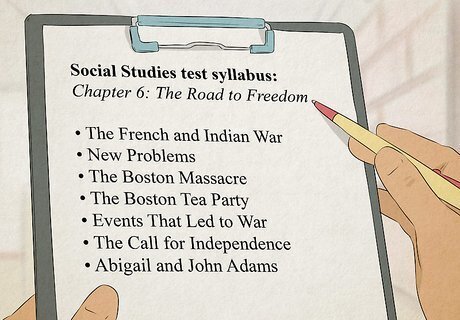
Read the study guide and test instructions closely. It’s important to review all the information your teacher provides about the test. Listen carefully when they talk about an upcoming exam, and take notes on what they say. If you’re provided with a study guide, spend your study time reviewing the material listed on it so you’ll be prepared for the material you’ll be tested on.

Make your own flash cards. Although you might find suitable flash cards online, creating your own will tailor the terms to your class and give you extra study time as you write them. Use your flash cards for 10-20 minutes every day to improve your memory retention. Do not add more than 1-2 sentences of information per flash card so the content is easy to remember. Flash cards are especially useful for memorizing notable people, events, or dates. Color code your flash cards to organize them and make memorization a little easier. You might, for example, highlight all major dates in pink, all historical figures in blue, and all important events in yellow.
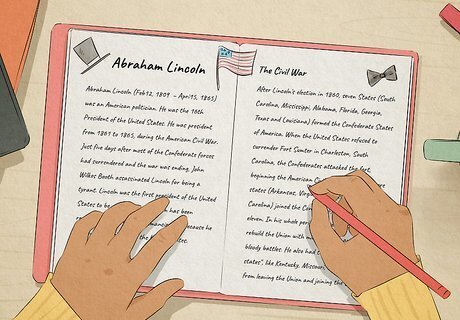
Add visuals aids to your notes. Images can be much easier to remember during a test than note pages. Draw a picture while outlining or studying your notes to help you remember important facts. You might even put visual aids on your flash cards to help you recall difficult-to-remember terms. Make your pictures simple so you can easily bring them to mind while taking your exam. If you're trying to remember who the sixteenth president of the United States is, for example, you could draw a top hat to symbolize Abraham Lincoln. Or you could draw an ocean wave to remember that Napoleon's army lost the Battle of "Water"-loo.

Teach someone else. Sometimes, speaking your notes aloud can help them solidify in your mind. Ask your parents or guardians, siblings, or friends if you can teach them a lesson on a concept from your classes. Try to sum up the core concepts for them in a few paragraphs. Let them ask any questions they have afterwards to practice for your test. Make a list of important figures or events beforehand to bring up while you "teach" this person. If you can't find someone to help you, teach an imaginary student or a stuffed animal.

Re-read your chapters with specific questions in mind. Study each chapter with a predetermined purpose. Think about major themes, figures, or events you studied this term and keep an eye out for them as you skim the chapter. If you're not sure which themes are most important, pay close attention to chapter subheadings or ask your teacher for guidance. Write down memorable chapter headings to include in your vocabulary list. Study your textbook with the goal to bring chapter themes together instead of reading in chronological order.
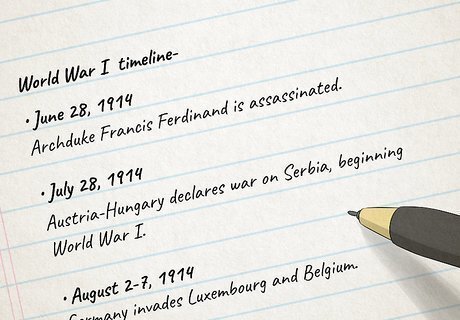
Make timelines out of your notes. If you have to memorize events in chronological order, create a timeline to help you visualize the event order more clearly. First, write down all events that you can recall from memory. Then, search your textbook and notes to add in other important events. Highlight any events that you have a hard time remembering so you can study them more before taking the test.
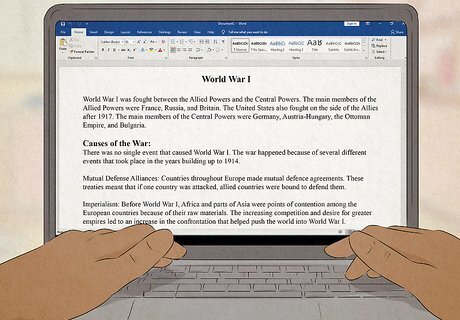
Synthesize your notes into paragraphs to make sure you understand them. To summarize your notes into concise chunks, turn them into paragraphs with 4-6 sentences. Re-write all of your class or textbook notes twice. First, synthesize them with the notes in front of you. Then, when you're ready, write another paragraph without any notes or study materials in sight. This method can help you prepare for short-answer or essay questions. Try to recall at least 5 sentences' worth of information when writing your paragraphs without notes.
Taking Practice Tests
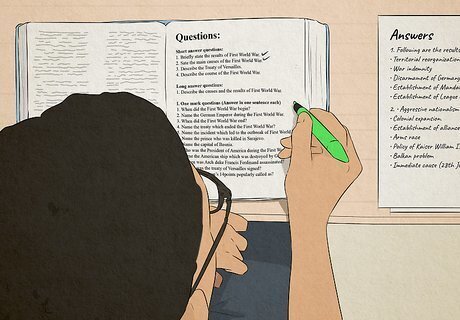
Answer every practice problem in your textbook. Most books will have practice questions next to chapter or section summaries. When you're skimming your textbook before the test, write down every question. Answer them as you find the answer in the corresponding questions. Later, you can convert these question/answer pairs into flashcards.
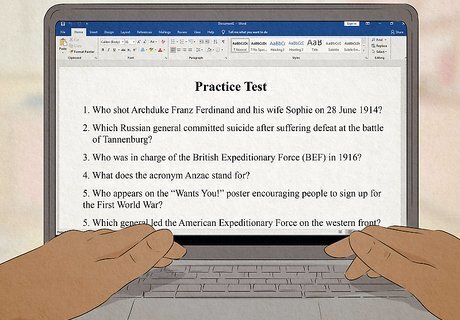
Make your own practice test based on your notes. You might be able to find a practice test online, but for a more personal study session, prepare questions for yourself based on concepts you talked about in class. Pay special attention to any points you're weak on and make more questions on those concepts. Write your questions based on major themes covered in your class or textbooks. Wait at least a day before taking the test so you can start it with fresh eyes.
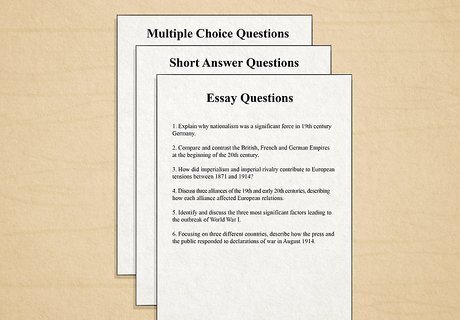
Fill your test with a variety of questions. Ask your teacher what kinds of questions will be on the test, and model your practice test off of their response. Focus your test on whatever type of questions you are most nervous on answering. If your test is a 50/50 split of matching and essay questions but you're most worried about the matching section, add more of those.

Find a distraction-free environment to take your test. Practice the test in an environment that mimics both your study spot and how quiet it will be while taking the real test. Libraries or study tables can both provide the right atmosphere. Bring only materials you can use on the test, like pencils, scratch papers, and erasers.
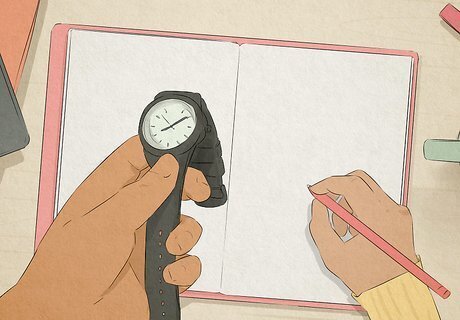
Time yourself. Ask your teacher if your social studies test will be timed. If it is, complete the practice tests just like you would the real thing. Set a timer before you start the test, and keep an eye on it as you work through the problems. Plan to divide your time between the different sections so you can work effectively. If you don't complete the practice test in time, don't work yourself up. Continue doing practice tests to improve your time. Start with the answers you know and skip anything you're unsure about. Return to these questions after you've answered everything else so you can finish as much of the test as possible.
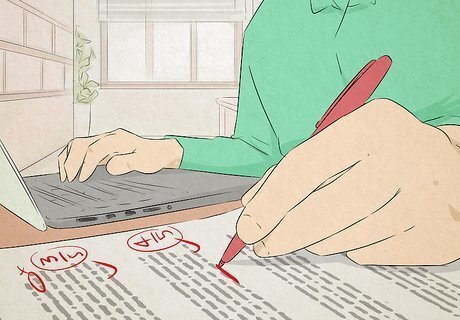
Score your test and review your mistakes. Once you've finished your practice test, look up the answers in your textbook or go over it with a classmate. Take note of answers you've missed, and create a follow-up practice test centered around these incorrect questions.
Studying at the Right Time and Place

Study when you feel most energized. Some people study best when they wake up an hour before they normally would to study. Others are night owls and like to study in the evening. Think about when you think most clearly, and try to schedule a study session during this time. Pick a time that also works best with your schedule. Even if you study best at around 6 PM, your parents or guardians might not want you to skip dinner. Try studying an hour earlier or later. Avoid using sugar or caffeine to stay alert. The energy highs and lows can make study sessions less productive.
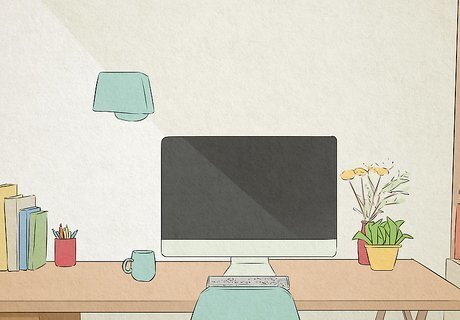
Choose a quiet place with no distractions. Look for a place where nobody can bother you, like your school library, your bedroom, or a park table. Keep anything that would distract you, such as your phone or video game consoles, out of sight. Turn off your phone while you're studying to avoid getting sucked into text or social media notifications. If you can't work without background music, put on some instrumental music. Lyrics can distract you from studying.

Make sure your chosen spot is comfortable. Depending on how long you're studying, you'll want a place where you can sit down for at least 45-60 minutes. Avoid hard chairs or cramped spaces. If you're studying on a desk, make sure you keep good posture to avoid backaches.
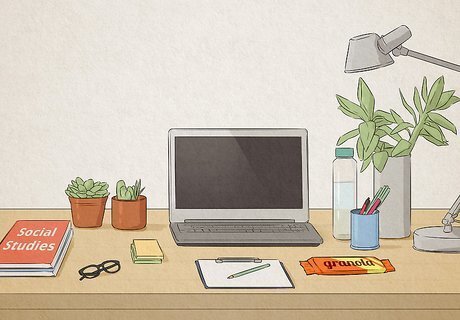
Prepare everything you will need before you begin studying. To avoid having to get up and down while you're studying, make a list of everything you will need first. Include materials like your textbook, school notes, a pen and paper, and anything else you can think of. Re-check your list after you've set up your study space to make sure you've got everything. Don't forget to prepare some brain-powering studying snacks like popcorn, almonds, string cheese, fruits, vegetables, granola bars, and water.
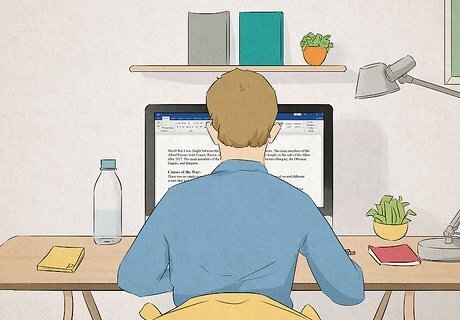
Study in the same place for all your sessions. Developing a routine can help you get into a studying mindset faster. If you can't study in the same place each time, try to recreate the same studying conditions each time. Play similar music, use the same materials, and study during the same time frame every day.

Form a study group with your peers before the test. Ask your teacher if before or during class, you can pass around a sign-up sheet for classmates interested in studying together. Contact every person on the study group to determine a time where you can all practice flashcards, look through notes, or take practice tests together. Begin your study group at least a week before the test begins to get the most out of your study sessions. Have students include their phone number or email on the contact sheet so you can coordinate easily. Invite a mixture of friends and classmates you don't know as well to avoid turning the study session into a social hour. Participating in a study group can help you see other perspectives. Your classmates likely have different ideas about what the test will focus on, which can help you prepare better.















Comments
0 comment